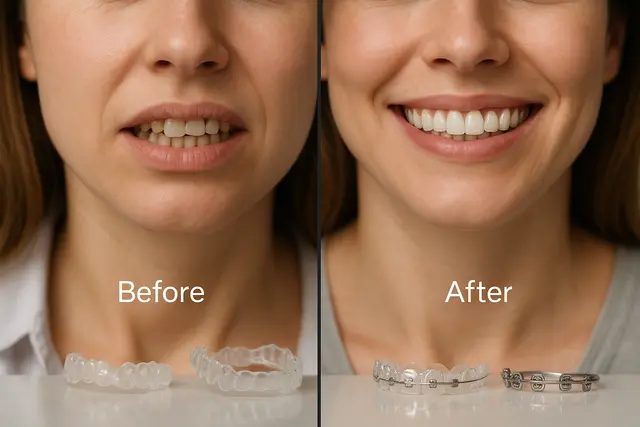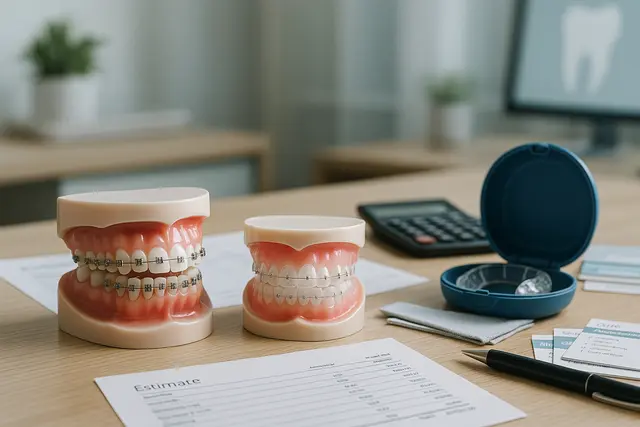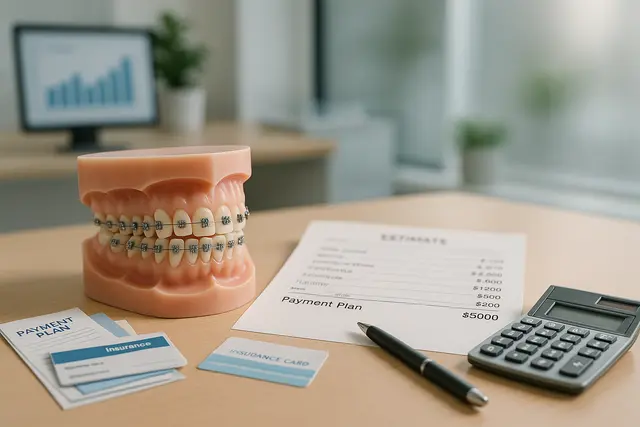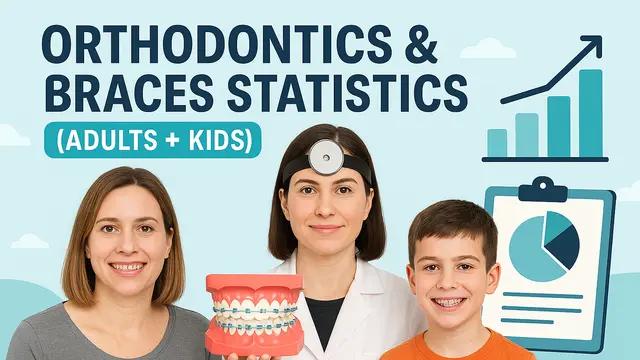Orthodontics
4 min read
Aug 13, 2025
Teeth Straightening Before and After: How Braces and Aligners Transform Smiles
A straight, confident smile can transform not only your appearance but also your oral health and overall well-being. Modern orthodontic treatments like braces and Invisalign make it possible to correct crowding, bite issues, and misalignments with remarkable results for patients of all ages.

If you've ever hidden your smile in photos or felt self-conscious about crowded front teeth, you're definitely not alone. The good news? Whether it's traditional braces or sleek Invisalign aligners, teeth straightening has come a long way. The results are not only dramatic on your smile but can boost your confidence, improve your bite, and make brushing a whole lot easier.
Let’s break down what happens before and after braces or Invisalign, and how those little devices work their magic on even the most stubborn crowding.
Brace Yourself: What to Expect With Braces
Braces aren’t what they used to be. Sure, metal braces are still around and working hard, especially for complex cases. Think severe crowding, deep bite issues, or an anterior open bite where the front teeth don’t touch when you close your mouth. For those cases, traditional metal braces or fixed braces give orthodontists more control to guide each tooth into its happy place.
If you wore braces as a teenager, you might remember the brackets, wires, and maybe the dreaded elastics. But many dental patients today, including adults, are choosing braces to correct overlapping front teeth, lower teeth crowding, or even to widen a narrow upper arch. Damon braces and clear braces are also popular for a less flashy look.
Using Invisalign to Straighten Without the Metal
For those wanting a less noticeable option, Invisalign is the clear winner. These nearly invisible aligners are custom-made to gently shift teeth over time. They're an excellent alternative to traditional metal braces, especially for mild to moderate crowding or spacing problems.
Invisalign treatment to close a gap or correct the alignment of upper teeth often takes less time than expected. One patient had 14 months of Invisalign and saw dramatic improvement in the crowding of her teeth, especially the lower front teeth that had become crowded after her baby teeth made way for adult teeth.
Another benefit? You can remove the aligners when you eat, floss, or need to flash a metal-free smile at a big event.
Straighten the Teeth, Improve Your Life
A straighter smile isn’t just about vanity. When teeth are crowded or overlapping, it's harder to keep them clean, leading to plaque buildup and possibly gum issues. Straightening teeth helps create better spacing, making it easier to floss and brush. This means your next dental checkup might feel a lot less intimidating.
Plus, teeth straightening treatment can help correct bite issues like an open bite or deep bite. That means less wear on your top and bottom teeth and fewer jaw aches from misalignment.
Crowd Control: Why Teeth Become Crooked
Let’s talk about the reason behind crooked teeth. Genetics is a big one. If your parents had crowded teeth, chances are your adult teeth might be following suit. Baby teeth falling out too early (or too late), thumbsucking, or just not having enough space in the jaw can all cause teeth to fit where they probably shouldn’t.
Over time, upper and lower teeth may shift. Even people who previously wore braces can experience teeth overlap again if they skip wearing retainers. That’s why fixed and removable retainers are part of every orthodontic treatment plan.
Lower Teeth Crowd Without Warning
Crowded lower teeth are extremely common, especially as we age. Our jaws slightly narrow over time, and those lower front teeth? They’re the first to get pushed out of alignment. One woman had teeth extracted in her teens but skipped her retainer. Fast forward to adulthood, and her lower teeth were crowded again. Braces to correct the crowding and Invisalign treatment took just over a year to improve her smile and align both upper and lower teeth properly.
Open Bite, Deep Bite, and Other Bite Drama
Not everyone comes in with teeth that are just a little off. Some have bigger issues, like an open bite where the upper and lower front teeth don’t meet, or a deep bite that causes excessive wear on the upper lateral incisors. Orthodontic treatment like braces to widen the upper jaw or Invisalign to guide teeth back into alignment can resolve these problems, while also delivering that beautiful smile.
The Benefits of Braces Go Beyond Looks
Straight teeth look fantastic, no doubt. But the benefits of braces also include:
Improved chewing
Reduced risk of dental trauma
When teeth are present in the right positions, they’re easier to clean and less likely to get chipped.
Many dental professionals also recommend teeth whitening once orthodontic treatment is complete, especially if teeth were slightly stained from overlapping or shadowing. Straight teeth make whitening treatments more effective, and let’s be honest, who doesn’t want that finishing sparkle?
Adult Braces and Realistic Timelines
Adult braces aren’t just a trend; they’re a practical choice for anyone who missed out as a kid or whose teeth have shifted. Treatment varies. Some cases need only six months, others go for 14 months or longer, especially when dealing with upper and lower fixed braces and severe crowding.
A good orthodontist in London (or wherever you are) can assess whether you need braces to straighten upper and lower teeth, Invisalign aligners for a mild correction, or a combo plan. The goal is always the same: teeth that look great, function well, and don’t keep shifting into chaos every few years.
What Are the Main Benefits of Braces and Invisalign?
Both braces and Invisalign improve more than just the appearance of your smile. They can correct crowding, close gaps, and align the bite so upper and lower teeth fit together properly. This not only makes chewing and speaking easier but also reduces uneven enamel wear and the risk of gum problems. Many patients also report increased confidence after treatment.
How Do Braces and Invisalign Treat Crowding and Bite Problems?
Braces are effective for mild to severe crowding and can handle complex bite issues, sometimes requiring extractions for space. Invisalign works well for mild to moderate crowding and certain bite corrections using clear, removable aligners. Both approaches gradually shift teeth into proper alignment, improving function and making it easier to maintain oral hygiene.
Why Do Some Adults Choose Clear Braces or Invisalign?
Adults often prefer clear braces or Invisalign because they are less noticeable than traditional metal braces. Clear braces blend with natural teeth while Invisalign aligners are nearly invisible and removable, making them more convenient for eating and cleaning. These options allow patients to achieve straighter teeth discreetly, without compromising professional or social comfort.
What Happens After Teeth Straightening Treatment?
After braces or Invisalign, patients usually wear retainers to keep teeth in their new positions. Some choose teeth whitening for a brighter, more polished smile. Minor adjustments may be made later with aligners if teeth shift over time. Consistent retainer use is essential to maintain results and protect the investment in orthodontic treatment.
Read Next
Related Posts

Orthodontics
Retainer That Looks like Braces: Benefits for Long-Term Alignment
A retainer might not get as much attention as braces, but it plays a crucial role in maintaining your smile after orthodontic treatment. Whether you're new to retainers or curious about the type that looks like braces, understanding their purpose and benefits is key to keeping your teeth aligned for the long haul.
6 min read
Sep 15, 2025

Orthodontics
How Much Are Metal Braces? Cost Comparison With Other Options
Thinking about getting braces but overwhelmed by the cost? You’re not alone. Orthodontic treatment can be a major investment, and understanding the different price points, from metal braces to clear aligners, can help you make a smart, confident decision.
5 min read
Sep 15, 2025

Orthodontics
Orthodontics & Braces Statistics (Adults + Kids)
Orthodontics has transformed from a niche medical service for teenagers into a booming sector that spans all ages. Today, both adults and children seek orthodontic treatment to improve their smiles, fix bite issues, and boost self-confidence.
4 min read
Aug 21, 2025
Don’t have time to research every dentist around you?
See why 30k+ patients trusted us